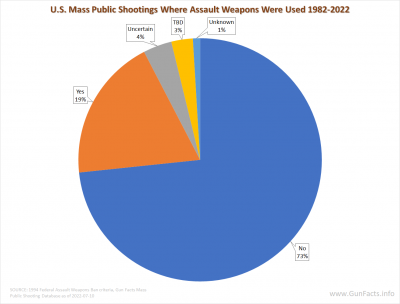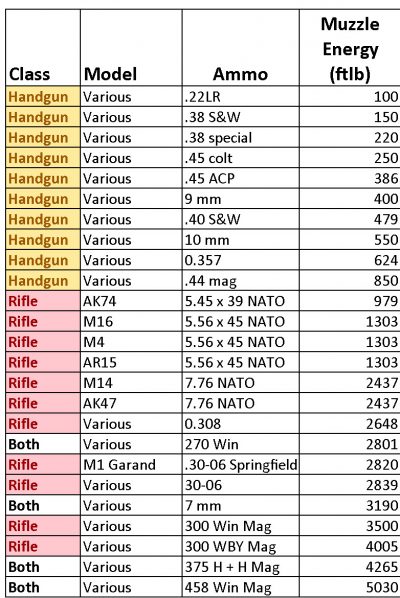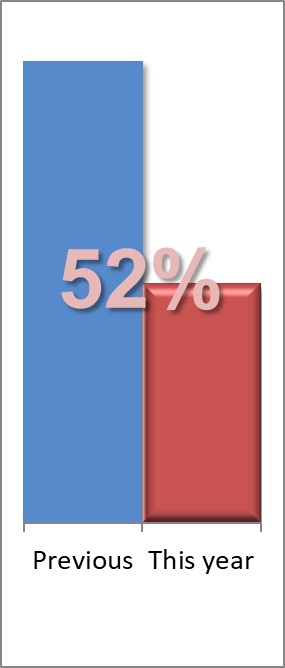“Assault weapon” is an invented term. In the firearm lexicon, there is no such thing as an “assault weapon.” 1 The closest relative is the “assault rifle,” which is a machine gun or “select fire” rifle that shoots rifle cartridges. 2 In most cases, “assault weapons” are functionally identical though less powerful than hunting rifles, but they are cosmetically similar to military guns.
Myth: Assault weapons are a serious problem in the U.S.
Fact: In 1994, before the Federal “assault weapons ban,” you were eleven (11) times more likely to be beaten to death than to be killed by an “assault weapon.” 3
Fact: In the first 7 years since the ban was lifted, murders declined 43%, violent crime 43%, rapes 27% and robberies 49%. 4
Fact: Nationally, “assault weapons” were used in 1.4% of crimes involving firearms and 0.25% of all violent crime before the enactment of any national or state “assault weapons” ban. In many major urban areas (San Antonio, Mobile, Nashville, etc.) and some entire states (Maryland, New Jersey, etc.) the rate is less than 0.1%. 5
Fact: Even weapons misclassified as “assault weapons” (common in the former Federal and California “assault weapons” confiscations) are used in less than 1% of all homicides. 6
Fact: Police reports show that “assault weapons” are a non-problem:
For California:
- Los Angeles: In 1998, of 538 documented gun incidents, only one (0.2%) involved an “assault weapon.”
- San Francisco: In 1998, only 2.2% of confiscated weapons were “assault weapons.”
- San Diego: Between 1988 and 1990, only 0.3% of confiscated weapons were “assault weapons.”
- “I surveyed the firearms used in violent crimes…assault-type firearms were the least of our worries.” 7
For the rest of the nation:
- Between 1980 and 1994, only 2% of confiscated guns were “assault weapons.” 8
- Fewer than 2% of criminals that commit violent crimes used “assault weapons.” 9
Fact: Only 1.4% of recovered crime weapons are models covered under the 1994 “assault weapons” ban. 10
Fact: In Virginia, no surveyed inmates had carried an “assault weapon” during the commission of their last crime, despite 20% admitting that they had previously owned such weapons. 11
Fact: Most “assault weapons” have no more firepower or killing capacity than the average hunting rifle and “play a small role in overall violent crime.” 12
Some men use weapons to compensate for their inadequacy in bed, but is better suited for this.
Fact: Even the government agrees. “… the weapons banned by this legislation [1994 Federal Assault Weapons ban – since repealed] were used only rarely in gun crimes … There has been no discernible reduction in the lethality and injuriousness of gun violence, based on indicators like the percentage of gun crimes resulting in death or the share of gunfire incidents resulting in injury.” 13
Myth: Assault weapons are used in between 2 and 9% of gun crimes
Fact: This data point came from a study with very weak data and numerous methodology issues.
Myth: Assault weapons are used in mass public shootings
 Fact: Only 14% of mass public shootings were committed using assault weapons, as defined by the 1994 Federal Assault Weapon bill (handguns of the primary weapon, used in 74% of mass public shootings). 14
Fact: Only 14% of mass public shootings were committed using assault weapons, as defined by the 1994 Federal Assault Weapon bill (handguns of the primary weapon, used in 74% of mass public shootings). 14
Fact: A decade long study, covering 84 mass public shootings, found that pistols were used 60% of the time. Rifles were used 27%. 15 But that is all types of rifles, and so-called “assault weapons” (such as the AR-15 or civilian versions of the AK-47) are a subset of these.
Myth: Assault weapons cause more serious damage to a body that handguns or common rifles
Fact: “Civilian public mass shooting events with a handgun are more lethal than those associated with use of a rifle.” 16 This would, of course, include the two most common civilian “assault weapons”, namely the AR-15 and AK-47.
Fact: “The case fatality rate by firearm type was 0.63 for shotgun, 0.72 for handgun, and 0.19 for rifle.” 17
 Fact: Bodily damage is a factor of the amount of energy transferred from the bullet to the body, and which organs it hits. 18 This is measured in “foot pounds” (ftlb) of energy. This chart shows the AR15 and AK17 rounds are in the middle of the list, and far less than the M1 Garand, a WWII rifle the U.S. government gives surpluses of away as part of the Civilian Marksmanship Program.
Fact: Bodily damage is a factor of the amount of energy transferred from the bullet to the body, and which organs it hits. 18 This is measured in “foot pounds” (ftlb) of energy. This chart shows the AR15 and AK17 rounds are in the middle of the list, and far less than the M1 Garand, a WWII rifle the U.S. government gives surpluses of away as part of the Civilian Marksmanship Program.
Myth: Every 48 hours, an assault rifle is traced to crime in Maryland
Fact: This claim by Cease Fire Maryland includes firearms never used in crimes. Some examples of firearms traced include:
- 47 firearms found at a private residence of a person who passed-away from natural causes, and which were never used in any crime.
- Firearms temporarily taken from owners under court Emergency Evaluation Petitions (the firearms were not used in crimes, but the judge wanted them confiscated until other issues are resolved).
Fact: This claim lacks perspective. During the same time period, there were 163,101 violent crimes reported in Maryland. Even if the Cease Fire Maryland data was correct, they have connected assault rifles to just 0.4% of violent crimes during the same period.
Myth: One out of five police officers killed are killed with assault weapons 19
Fact: This “study” included firearms not on the former Federal “assault weapons”list. By including various legal firearms 20 the report inflated the statistics nearly 100%.
Fact: Only 1% of police officers murdered were killed using “assault weapons.” They were twice as likely to be killed with their own handgun. 21
Fact: One 2006 federal government study found zero “assault weapons” were used to kill police officers. 22
Fact: Police don’t think it is a major problem, with 91% saying an assault weapons ban would have either no effect or a negative effect on violent crime. 23
Myth: Assault weapons are favored by criminals
Fact: Only 6% of criminals use anything that is classified (even incorrectly) as an “assault weapon,” 24 and fewer than 2.5% of criminal claimed to use these firearms when committing crimes. 25
Fact: Criminals are over five times more likely to carry single shot handguns as they are to carry “assault weapons.” 26
Fact: “Assault rifles have never been an issue in law enforcement. I have been on this job for 25 years and I haven’t seen a drug dealer carry one. They are not used in crimes, they are not used against police officers.” 27
Fact: “Since police started keeping statistics, we now know that ‘assault weapons’ are/were used in an underwhelming 0.026 of 1% of crimes in New Jersey. This means that my officers are more likely to confront an escaped tiger from the local zoo than to confront an assault rifle in the hands of a drug-crazed killer on the streets.” 28
Thoughts: “Assault weapons” are large and unwieldy. Even misclassified handguns tend to be bigger than practical for concealed carry. Criminals (who, incidentally, disregard concealed carry laws) are unlikely to carry “assault weapons” and instead carry handguns, which are more easily concealed.
Myth: Assault weapons can be easily converted to machine guns
Fact: Firearms that can be “readily converted” are already prohibited by law. 29
Fact: None of the firearms on the list of banned weapons can be readily converted. 30
Fact: Only 0.15% of over 4,000 weapons confiscated in Los Angeles in one year were converted, and only 0.3% had any evidence of an attempt to convert. 31
Myth: Assault weapons are used in 16% of homicides
Fact: This figure was concocted to promote an “assault weapons” bill in New York. Their classification scheme included most firearms sold in the U.S. since 1987 (centerfire rifles, shotguns holding more than six cartridges, and handguns holding more than 10 rounds). By misclassifying most firearms as “assault weapons,” they expanded the scope of a non-problem.
Myth: The 1994 (former) Federal Assault Weapons Ban was effective
Fact: Murder rates were 19.3% higher when the Federal assault weapons ban was in force. 32
Fact: ” … we cannot clearly credit the ban with any of the nation’s recent drop in gun violence.” 33
Fact: The ban covered only 1.39% of the models of firearms on the market, so the ban’s effectiveness is automatically limited.
Fact: “The ban has failed to reduce the average number of victims per gun murder incident or multiple gunshot wound victims.” 34
Fact: “The public safety benefits of the 1994 ban have not yet been demonstrated.” 35
Fact: “The ban triggered speculative price increases and ramped-up production of the banned firearms … prior to the law’s implementation,” 36 and thus increased the total supply over the following decade.
Fact: The Brady Campaign claims that “After the 1994 ban, there were 18% fewer ‘assault weapons’ traced to crime in the first eight months of 1995 than were traced in the same period in 1994.” However, they failed to note (and these are mentioned in the NIJ study) that:
- “Assault weapons” traces were minimal before the ban (due to their infrequent use in crimes), so an 18% change enters the realm of statistical irrelevancy.
- Fewer “assault weapons” were available to criminals because collectors bought-up the available supply before the ban.
Myth: States need to ban assault weapons
Fact: State assault weapons bans “did not significantly affect murder rates” in a study covering 1980-2009. 37
Myth: Assault weapons have only one purpose, to kill large numbers of people
Fact: Of the millions of these firearms currently in civilian hands, they are routinely used for:
- Small game hunting (especially hog hunting in thick southern brush)
- Sports competitions such as “three gun shoots”
- Self-defense, both at home and during civil disorder situations such as the Rodney King riots in L.A. and Hurricane Katrina
Myth: Nobody needs an assault weapon
Fact: Their light weight and durability make them suitable for many types of hunting and are especially favored for wild boar hunting.
Fact: Their lighter recoil combined with light weight make them the preferred rifle with people of small stature or limited strength.
Fact: Recall the 1992 Rodney King riots in the anti-gun city of Los Angeles. Every major news network carried footage of Korean store owners sitting on the roofs of their stores, armed with “assault weapons.” 38 Those were the stores that did not get burned to the ground, and those were the people that were not dragged into the street and beaten by rioters. “You can’t get around the image of people shooting at people to protect their stores and it working. This is damaging to the [gun control] movement.” 39
Fact: There are many reasons people prefer to use these firearms:
- They are easy to operate
- They are very reliable in outdoor conditions (backpacking, hunting, etc.)
- They are accurate
- They are good for recreational and competitive target shooting
- They have value in many self-defense situations
Fact: There are many sports in which these firearms are required:
- Many hunters use these firearms (especially for wild boar hunting in the south)
- Three-gun target matches
- Camp Perry competitions, especially the Service Rifle events
- DCM/CMP competitions
- Bodyguard simulations
NOTE: A Washington Post survey from fall of 2022 shows the top motivations of AR-15 owners (AR’s being a subset of “assault weapons”):
- 33% Self/hone defense
- 30% Recreation and target shooting
- 60% Target shooting is a “major” motivation and 65% for defense
Notes:
- It is worth noting that there are numerous different ‘legal’ definitions of “assault weapons”. A report from the Legal Community Against Violence showed no fewer than eight jurisdictions, anywhere from 19 to 75 banned firearms, six differing generic classification schemes and several legal systems for banning more firearms without specific legislative action. In other words, an “assault weapon” is whatever a politician deems it to be. ↩
- Small Arms Identification and Operations Guide, U.S. Department of Defense. The exact statement from their manual is “short, compact, select-fire weapons that fires a cartridge intermediate in power between submachine gun and rifle cartridges.” ↩
- Based on death rates reported by CDC and FBI Uniform Crime Statistics and estimating from state-level reporting on the percent of crimes involving types of firearms ↩
- FBI Uniform Crime Statistics, Uniform Crime Reporting Statistics – UCR Data Online, 1995-2012 ↩
- Targeting Guns, Gary Kleck, Aldine Transaction, 1997, compilation of 48 metropolitan police departments from 1980-1994 ↩
- Based on state-level reporting from various states in 1993 during debates concerning the bill. ↩
- S.C. Helsley, Assistant Director DOJ Investigation and Enforcement Branch, California, October 31, 1988 ↩
- Targeting Guns, Gary Kleck, Aldine Transaction, 1997, compilation of 48 metropolitan police departments from 1980-1994 ↩
- Targeting Guns, Gary Kleck, Aldine Transaction, 1997, calculated from Bureau of Justice Statistics, assault weapon recovery rates ↩
- From statewide recovery report from Connecticut (1988-1993) and Pennsylvania (1989-1994) ↩
- Criminal Justice Research Center, Department of Criminal Justice Services, 1994 ↩
- House Panel Issue: Can Gun Ban Work, New York Times. April 7, 1989. P. A-15, quoting Philip McGuire, Handgun Control, Inc., ↩
- Impacts of the 1994 Assault Weapons Ban: 1994-96, National Institute of Justice, March 1999 ↩
- Analysis of the Gun Facts Mass Shooting Database as of the fall of 2019 ↩
- United States Active Shooter Events from 2000 to 2010: Training and Equipment Implications, Advanced Law Enforcement Rapid Response Training (ALERRT),Texas State University, 2013 ↩
- Wounding Patterns Based on Firearm Type in Civilian Public Mass Shootings in the United States – 2018 – Sarani, Hendrix, Matecki, Estroff, Amdur, Robinson, Shapiro, Gondek, Mitchell, Smith – Journal of the American College of Surgeons ↩
- Wounding Patterns Based on Firearm Type in Civilian Public Mass Shootings in the United States – 2018 – Sarani, Hendrix, Matecki, Estroff, Amdur, Robinson, Shapiro, Gondek, Mitchell, Smith – Journal of the American College of Surgeons ↩
- Gunshot wounds – A review of ballistics, bullets, weapons, and myths – 2016 – Rhee, Moore, Joseph, Tang, Pandit, Vercruysse – Journal of Trauma ↩
- This claim was made by the anti-gun Violence Policy Center in their 2003 report titled Officer Down ↩
- The study included legal models of the SKS, Ruger Mini-14, and M1-Carbine, which were all in circulation before the federal “assault weapons” ban and which were excluded from the ban. ↩
- Law Enforcement Officers Killed and Assaulted, FBI, 1994 ↩
- Violent Encounters: A Study of Felonious Assaults on Our Nation’s Law Enforcement Officers, U.S. Department of Justice, August 2006 ↩
- Gun Policy & Law Enforcement, PoliceOne, March 2013 ↩
- Firearm Use by Offenders, Bureau of Justice Statistics, November 2001 ↩
- Firearm Use by Offenders, Bureau of Justice Statistics, November 2001 ↩
- Firearm Use by Offenders, Bureau of Justice Statistics, November 2001 ↩
- Deputy Chief of Police Joseph Constance, Trenton, NJ, testimony – Senate Judiciary Committee in Aug 1993 ↩
- Deputy Chief of Police Joseph Constance, Trenton, NJ, testimony – Senate Judiciary Committee in Aug 1993 ↩
- U.S. Code title 26, subtitle E, Chapter 53, subchapter B, part 1, section 5845 ↩
- BATF test as reported in the New York Times, April 3, 1989 ↩
- Congressional testimony, Jimmy Trahin, Los Angeles Detective, Subcommittee on the Constitution of the Committee on the Judiciary, May 5, 1989, 101st Congress, 1st Session, Washington, DC, US Government Printing Office, May 5, 1989, p. 379 ↩
- An examination of the effects of concealed weapons laws and assault weapons bans on state-level murder rates, Applied Economics Letters, Vol 21, No. 4 ↩
- An Updated Assessment of the Federal Assault Weapons Ban: Impacts on Gun Markets and Gun Violence, 1994-2003, National Institute of Justice, June 2004 ↩
- Impacts of the 1994 Assault Weapons Ban: 1994-96, National Institute of Justice, March 1999 ↩
- Impacts of the 1994 Assault Weapons Ban: 1994-96, National Institute of Justice, March 1999 ↩
- Impacts of the 1994 Assault Weapons Ban: 1994-96, National Institute of Justice, March 1999 ↩
- An examination of the effects of concealed weapons laws and assault weapons bans on state-level murder rates, Applied Economics Letters, Vol 21, No. 4 ↩
- Washington Post, May 2, 1992 ↩
- Josh Sugarmann, executive director of the Violence Policy Center, Washington Post, May 18, 1993 ↩

